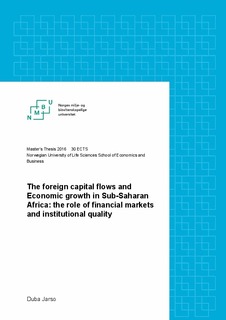| dc.contributor.author | Ifo, Duba Jarso | |
| dc.coverage.spatial | Africa | nb_NO |
| dc.date.accessioned | 2017-06-06T12:34:38Z | |
| dc.date.available | 2017-06-06T12:34:38Z | |
| dc.date.issued | 2017 | |
| dc.identifier.uri | http://hdl.handle.net/11250/2444463 | |
| dc.description.abstract | There are competing theories when comes to the effect of foreign capital inflows on the recipient country’s economic growth. The foreign capital inflows to the sub-saharan region has shown significant growth over last two decades which coincided with the relative economic progress in the region.
This study investigated the impact of foreign capital flows on Economic growth of Sub-
Saharan African countries. System Generalized Methodwas employed on 33 cross country panel in the period 1996 - 2014. The foreign flows mainly categorized into three categories: Aggregate foreign capital flows, disaggregated foreign capital inflows and foreign capital outflows (capital flight).
Aggregate capital flows, which was measured by current account balance, didn’t show significant impact on Economic growth in the region for the specified period. Inflows in the form of Official Development assistance, personal remittance and foreign direct investment, it was only official development assistance that found to have significant positive impact on the Economic growth. | nb_NO |
| dc.language.iso | eng | nb_NO |
| dc.publisher | Norwegian University of Life Sciences, Ås | nb_NO |
| dc.rights | Attribution-NonCommercial-NoDerivatives 4.0 Internasjonal | * |
| dc.rights.uri | http://creativecommons.org/licenses/by-nc-nd/4.0/deed.no | * |
| dc.title | The foreign capital flows and economic growth in Sub-Saharan Africa : the role of financial markets and institutional quality | nb_NO |
| dc.type | Master thesis | nb_NO |
| dc.description.localcode | M-DNRE | nb_NO |

